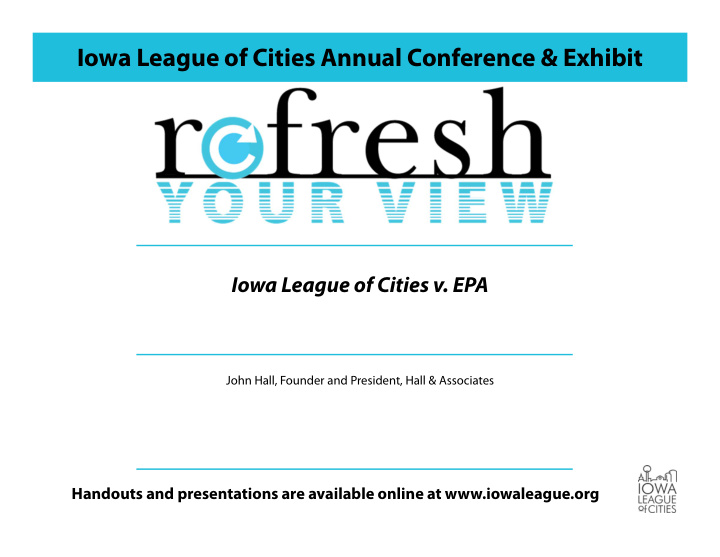



Iowa League of Cities Annual Conference & Exhibit Iowa League of Cities v. EPA John Hall, Founder and President, Hall & Associates Handouts and presentations are available online at www.iowaleague.org
Background • 2005-2008 EPA develops internal policies to regulate wet weather flows more stringently : – Blending prohibition – Bacteria mixing zone prohibition • States pressured to change rules or deny permits (through 2013) • Promoted state administrative orders and federal enforcement to ensure compliance 2
3 What is “Blending”
Mixing Zone Examples 4
Federal/State Activities Impacted • CSO LTCP, Stormwater, NPDES permits, WWTP design, SSO remedies, TMDLs, Schedules of compliance/enforcement orders • State rulemaking activities • Criteria updates and modification requests 5
Direct Municipal Consequences of EPA’s Activities • State’s limited remedial options for compliance • Communities selected more costly and time consuming options (detention basins versus peak flow treatment options) • Compliance reporting expanded on plant operations • Section 303(d) lists expanded • Bacteria standard modifications restricted • MS4 requirements expanded 6
How Did EPA Enforce This? • Threatened state agencies with objection letters • Email and informal correspondence • Federal and state consent decrees • Permit modifications, LTCPs • TMDL development • Cost Impact >$200 billion nationwide 7
Court Decision Summary Blending Ban: VACATED Bacteria Mixing Zone Ban: VACATED Regulating Blending: BEYOND EPA’S AUTHORITY 8
Flavor of the Decision • Tyranny of small decisions • Irreconcilable with • Eviscerated direct appellate rules review • Orwellian Newspeak • Eviscerate state discretion • Dissembling • Rulemaking masquerading as • Belated Backpedaling explication Hedging a concrete application of a policy within a disclaimer about hypothetical future contingencies does not insulate regulated entities from the binding nature of the obligations and similarly cannot serve to inoculate the agency from judicial review. 9
“Effluent Limitation or Other Limitation” • We agree that an agency action is a "limitation" within the meaning of section 509(b)(1)(E) if entities subject to the CWA's permit requirements face new restrictions on their discretion with respect to discharges or discharge-related processes “The EPA's position that bacteria mixing zones in waters "designated for primary contact recreation . . . should not be permitted" is a restriction that directly affects the concentration of discharge from a point source and therefore is an effluent limitation.” 10
Due Process Injury Protected Notice and comment procedures for EPA rulemaking under the CWA were undoubtedly designed to protect the concrete interests of such regulated entities by ensuring that they are treated with fairness and transparency after due consideration and industry participation. See, e.g., Chrysler Corp. v. Brown, 441 U.S. 281, 316, 99 S. Ct. 1705, 60 L. Ed. 2d 208 (1979) … Thus, the League has established an injury in fact related to the EPA's purported procedural deficiencies. 11
No Technology Mandate • The EPA has interpreted the CWA regime as "preclud[ing] [it] from imposing any particular technology on a discharger.“ • “The bypass rule does not require the use of any particular treatment method or technology…. The secondary treatment regulations also do not mandate the use of any specific type of technology.” • “Each facility has the discretion to select any technology design and process changes necessary to meet the performance-based discharge limitations and standards…” “EPA’s new blending rule is a legislative rule because it is irreconcilable with both the secondary treatment rule and the bypass rule.” 12
Mixing Zones • One element of state water quality standards are policies regarding "mixing zones.“ • But as one of its water quality standards, a state's policy on mixing zones remains subject to the triennial review of the EPA. “EPA eviscerates state discretion to incorporate mixing zones into their water quality standards with respect to this type of body of water.” 13
EPA Acted Beyond Statutory Authority • If we choose to vacate solely on procedural grounds, regulated entities who have already spent considerable time crossing the hot shoals of regulatory uncertainty must continue to do so. • [T]he blending rule clearly exceeds the EPA's statutory authority and little would be gained by postponing a decision on the merits. As discussed above, the September 2011 letter applies effluent limitations to a facility's internal secondary treatment processes, rather than at the end of the pipe. The EPA would like to apply effluent limitations to the discharge of flows from one internal treatment unit to another. We cannot reasonably conclude that it has the statutory authority to do so. 14
Status of Decision • Court Awarded > $500, 000 in Attorney’s Fees • EPA will likely seek Supreme Court Review – Not likely to be Granted This is just one of many EPA rule reinterpretations impacting municipalities 15
How to Achieve “Status quo Ante” • Revise unnecessary state rules • Revise state and federal orders • Reopen the schedules of compliance • Amend permits and LTCPs • Seek mixing zone approval • Revise the TMDLs • Amend impairment listings Meeting with DNR to Discuss Case Impacts 16
Curtain Call • Special thanks to the Mayor Uehling Iowa League of Cities, DNR and IAWEA for supporting this case. We would not be where we are today without you standing up for your rights where others have failed to do so.
Other Issues in the Wings • DNR Nutrient Strategy (~ $1.5 billion!!!) • EPA Affordability “Guidance” • Implementing GOM requirements w/o any applicable WQS or TMDL • EPA Stormwater Rule (Presumed Impairment) • Bypass rule defense/design storm • Arsenic/Fish Consumption Criteria 18
Center for Regulatory Reasonableness John C. Hall Hall & Associates 1620 I Street, N.W. Washington, DC 20006 (202) 463-1166
Recommend
More recommend